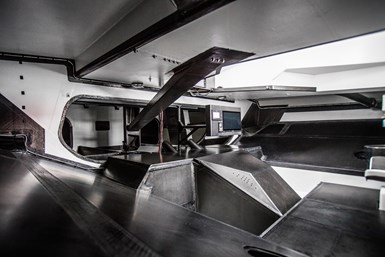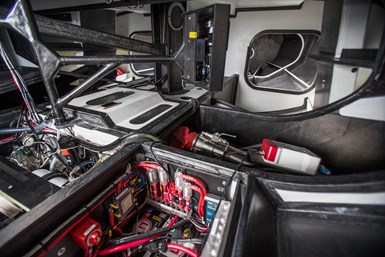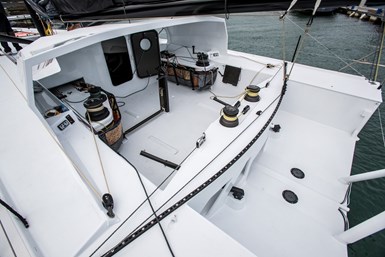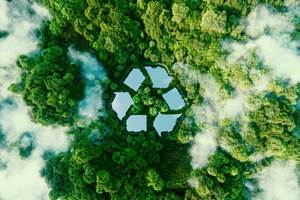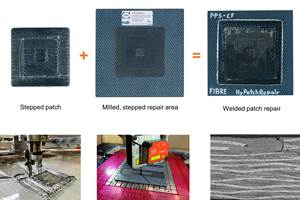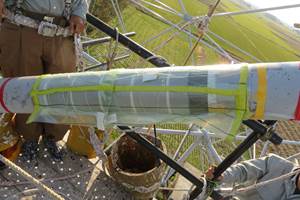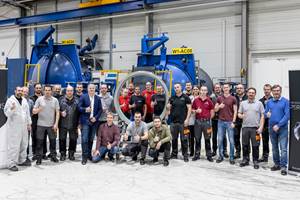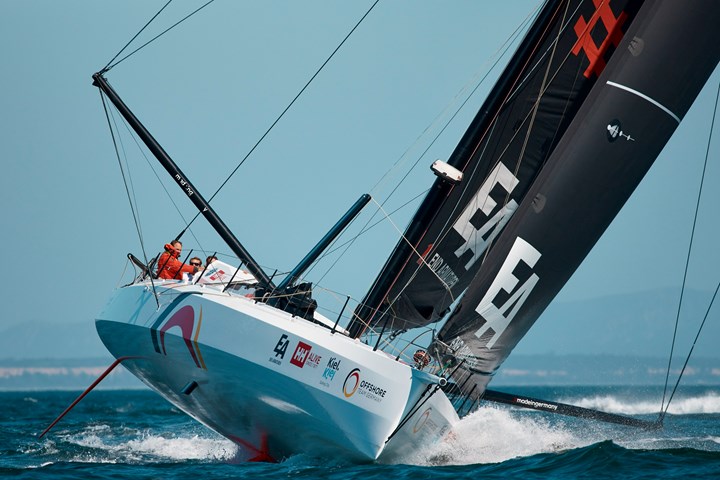
Almost a decade after its original manufacture, the resurrected Einstein yacht went on to win The Ocean Race Europe in 2021. Photo Credit, all images (and image above title): STRUCTeam Ltd.
Einstein, an IMOCA 60 racing yacht originally named Acciona, serves as an example of creative composites engineering not only for the manufacture of a high-performance marine vessel, but also, in this case, in its cost-effective and successful repair and restoration.
Originally designed by Owen Clarke Design (Dartmouth, U.K.) in 2012, Acciona was a 60-foot open monohull (per International Monohull Open Class Association [IMOCA] guidelines) racing yacht and served as a showcase for sustainable technologies, relying on solar, wind and water power to drive electronics and hydraulics. The yacht also showed a lot of potential to reach high speeds. Unfortunately, Acciona capsized due to a broken keel during its first race, the Vendée Globe, in 2013. The skipper was rescued, but it was several weeks before Acciona was able to be recovered from the ocean. Ultimately, due to the damage, the yacht was placed in storage for the next five years.
In 2017, racing team Offshore Team Germany (OTG) took ownership of Acciona, with the goal of repair and restoration. Jens Kuphal, manager of OTG, explains that IMOCA 60 racing yachts are among the fastest in the world, and, can thus be highly expensive to engineer and manufacture. Repair of an existing boat would, hopefully, present a more cost-effective option.
Acciona, however, was in bad shape, with a broken keel, missing mast, water damage throughout and considerable hull damage from a battery fire. Kuphal assembled a highly experienced team, at OTG and with partners Trimarine Shipyard (Lisbon, Portugal) for repair of the hull and STRUCTeam Ltd. (Cowes, U.K.) for the design and engineering work. OTG had worked with Trimarine for many years, and STRUCTeam’s principal engineer, Frederic Louarn, had worked on the original Acciona.
To begin the process, Trimarine’s team, led by owner Fernando Sena, surveyed the scale of the damage to Acciona’s hull, which is made from thin skins of unidirectional (UD) carbon fiber-reinforced plastic (CFRP) prepreg, sandwiching a core made from panels of foam or Nomex. Louarn notes, “We had to devise a strategy for repairing areas of damage without affecting the areas of the boat that were still sound. Gaining access to these areas was also challenging.”
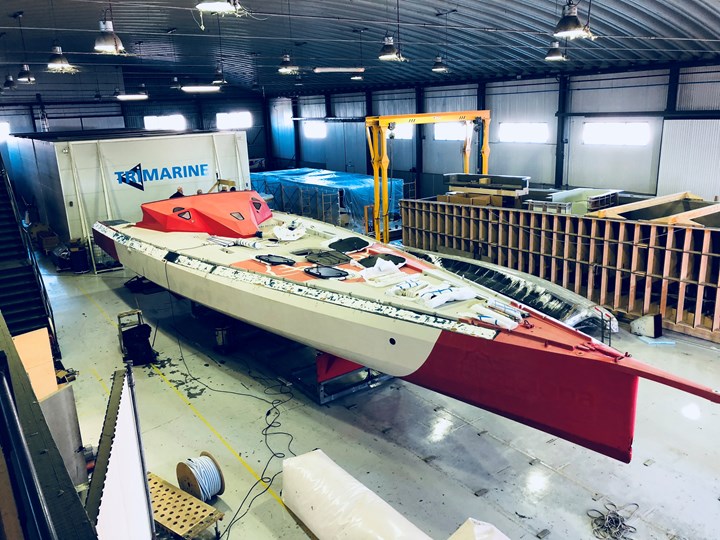
Repair of the waterlogged, damaged yacht took several years and was a collaborative effort by multiple teams.
One issue was the badly waterlogged hull. The surface of the hygroscopic, cellular Nomex core is slit to enable water vapor to escape during production when the hull is cured at elevated temperatures. However, this material also can also absorb water easily if the outer panel is damaged or perforated. Sena explains, “Even though the yacht had been in storage for some time, the water had no way of evaporating. We had to get rid of all that water from the core before we could seal off the laminates.”
To dry out the hull, Trimarine removed the damaged skins strategically, “to ensure that we didn’t weaken the structure and maintained the shape of the boat,” Sena says. The Nomex core underneath was then evaluated and either removed, if damaged, or dried out under a vacuum bag. “The pressure of the vacuum lowered the evaporation point of the water to almost room temperature,” he explains.
Since dryness is not always easily identified visually, infrared cameras were used along the damaged areas. Cold spots that appeared in the scans indicated areas that were still wet and in the process of evaporation; warm areas were completely dry.
Most of the repairs Sena and his team made were small, but there was an area of the hull of approximately two square meters in size where the skins on both sides — inside and out — had delaminated completely and the core was totally destroyed.
Repairing this damage was a delicate operation, Sena says. “We needed to make sure that the inner side of the hull was stable at all times before we removed the outer skin so that we did not lose its shape. We conducted some minor repairs on the inner skin to make sure that it was sealed, and then essentially built a mold to hold it in place so that we could then remove the outer skin and the core from the outside, chamfering it back. Then we vacuumed everything to remove all of the water, and once we were satisfied that everything was dry, we started bonding the core and applying the outer skin.” This work complete, the technicians removed the mold from the inside, took the inner skin off from the same place, and relaminated it.
An additional challenge was that, since Acciona’s initial construction, rules associated with the placement of ballast tanks in IMOCA 60 yachts — the structures that hold water and maintain hydrostatic stability for the boat — had changed. Previously, small tanks had to be located in the middle of the boat along the centerline; now, four larger tanks could be fitted to more outboard areas. STRUCTeam designed the new tanks, and Trimarine repositioned and reworked the existing tanks.
The biggest challenge with this process, Sena explains, is that it all occurred after the deck had been repaired and replaced on the yacht. “Normally [ballast repositioning work] would be achieved with the deck off, but we had to do it with the deck already on. We had to squeeze ourselves into some very small, dark holes. It was like being in a mine!”
Another large part of the repair process was redesign for the rig — on a yacht, the mast and sails. To bring the boat up to date, the previous mast was redesigned as a larger, more complex deck-spreader design. STRUCTeam came up with the new design, and also helped to develop new CFRP chainplates and modifications to the roof. By late 2018, several other additional modifications were added to the project when the OTG team learned that Acciona could compete in The Ocean Race, a competition that previously did not allow the entry of fully crewed IMOCA 60 yachts.
In March 2019, the repairs were completed, and Acciona was transferred to a shipyard in Gosport, U.K., for systems fit-out, painting and finishing.
By August 2019, OTG began racing the newly resurrected Acciona, now renamed Einstein. In August 2021, Einstein went on to win The Ocean Race Europe. “Not only has the team worked to upcycle this large structure, but we have also made it competitive with yachts that are 10 years younger and, as such, are more technologically advanced,” notes Julien Sellier, founder and managing director of STRUCTeam.
Sena adds, “It’s been great seeing the boat compete. Knowing where it came from, it’s quite amazing to see it doing so well.”
Related Content
Segula Technologies initiates Z-WasTEK project for composite recycling, repair
The combined use of 3R resin and the development of digital programs will target the repair and more responsible use of carbon fiber.
Read MoreDeveloping repairs for thermoplastic composite aerostructures
HyPatchRepair project proves feasibility of automated process chain for welded thermoplastic composite patch repairs.
Read MoreToray jointly wins Infrastructure Maintenance award for steel pipe repair innovation
Together with Tokyo Electric Power Grid and Yasuda Seisakusho, Toray employed in-situ VARTM with carbon fiber sheets to repair steel pipe corrosion on transmission towers, with application extension underway.
Read MoreFACC signs multiyear agreement with Pratt & Whitney for fan case MRO
FACC is growing its component repair services with the repair and overhaul of its customer’s composite PW800 turbofan engines.
Read MoreRead Next
“Structured air” TPS safeguards composite structures
Powered by an 85% air/15% pure polyimide aerogel, Blueshift’s novel material system protects structures during transient thermal events from -200°C to beyond 2400°C for rockets, battery boxes and more.
Read MoreVIDEO: High-volume processing for fiberglass components
Cannon Ergos, a company specializing in high-ton presses and equipment for composites fabrication and plastics processing, displayed automotive and industrial components at CAMX 2024.
Read MoreAll-recycled, needle-punched nonwoven CFRP slashes carbon footprint of Formula 2 seat
Dallara and Tenowo collaborate to produce a race-ready Formula 2 seat using recycled carbon fiber, reducing CO2 emissions by 97.5% compared to virgin materials.
Read More

.jpg;width=70;height=70;mode=crop)






